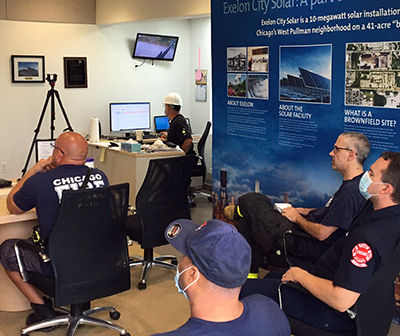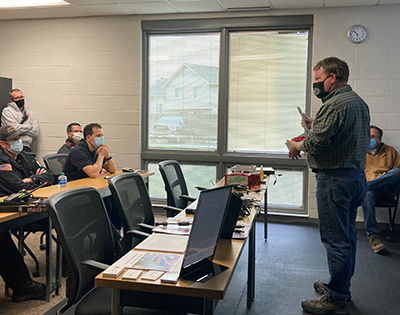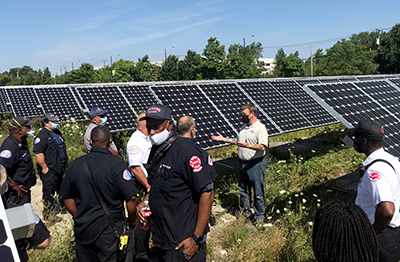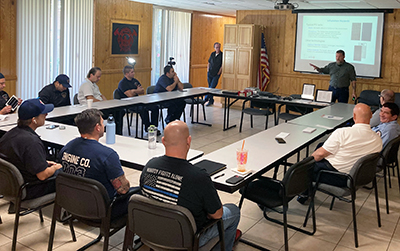It’s among a firefighter’s worst-case scenarios: An overnight call to a scene where the surroundings are dark and unfamiliar and every step poses life-threatening danger, not from flames or degraded structure—they’re used to that—but from live wires, trip hazards and physical impediments to the most basic of firefighting strategies.

|
|
Members of Chicago Local 134 have been helping Illinois firefighters understand some of the hidden challenges presented by rooftop and utility-grade solar installations.
|
This safety worry has played out night after night across the world as the use of commercial and residential solar power has grown over the last few decades. As builders and customers have turned to low-cost, low-environmental-impact photovoltaic and battery technology, firefighters have had to wrestle with the added dangers presented by rooftop panels.
It’s why lawmakers and building-code regulators have increasingly turned to updating rules for solar installations and fire departments have sought out additional training for crews responding to fires where solar is part of the safety equation. And who better to help lead that training than the men and women who often install the panels themselves?
At Chicago Local 134, whose jurisdiction covers all of Chicago and 133 other incorporated municipalities in Illinois’ Cook County, the opportunity to help neighboring fire departments navigate the potential dangers of solar power was one that local leaders couldn’t pass up. It started when representatives from the Alsip Fire Department, located near the local’s training center, reached out for help.
“They called us because they were starting to see more and more solar get installed within the last few years, and they knew we could help educate them,” said Local 134 business representative Robert Hattier, who worked to build a training curriculum around solar safety. “It made me realize, we’re always thinking of the electrical inspectors who work with permitting authorities to prevent problems, but what about the first responders’ safety?”
Already, Hattier has trained hundreds of firefighters at dozens of station houses throughout Illinois about the well-known and lesser-known dangers of solar power generation. He combines classroom-based lectures and discussions with hands-on experience when possible, giving first responders a chance to see and safely touch what they might be up against in an actual firefighting situation.
In July, Hattier trained Engine Company 115 of the Chicago Fire Department at a 10-megawatt facility on the city’s South Side. “As the responding company to the 40-acre site, it was important to address the specific concerns raised if they receive a call,” he said. Over three days, the first responders trained on and discussed procedures about gaining access to the site and how to mitigate potential hazards.
Modern Problems
For generations, a firefighter’s first jobs on the scene have been to disconnect power and then send crewmembers to the roof to cut holes, allowing thick smoke and toxic fumes trapped inside to escape. The two steps are all about safety. Live wires, low visibility and toxic air are an immediate danger to both firefighters and anyone still stuck inside.
But rooftop solar presents obstacles to both of those critical steps. When placed closely together, panels often impede crews’ ability to cut ventilation holes directly above the source of the fire, slowing the smoke-clearing process or making it completely impossible or exceedingly difficult in cases where panels cover an entire roof.
Plus, one of the greatest misconceptions about solar power—no sun, no power—can turn deadly, especially when fire crews turn up. Light trucks used by fire departments to illuminate nighttime scenes can quickly energize panels, which, when connected or hooked up to battery storage, can leave power running through wires that would normally be switched off at the street. Streetlights or nearby ambient light could even generate enough juice to pose a serious threat to rescue personnel.
“Firefighters can handle it when the panels themselves catch fire,” Hattier said. “But because it’s so hard to keep light sources from energizing a panel, it makes electrocution an even bigger danger for first responders.”

|
|
Through a combination of classroom-based and hands-on learning, trainers from Chicago Local 134 are hoping to help first responders to the variety of potential hazards in residential and commercial solar installations.
|
Emergency personnel responding to a blaze in the middle of the night can follow every procedure they know for shutting down the connections between the panels and the building’s electrical systems, and it still might not be enough to eliminate the risk that current is continuing to flow throughout the structure.
“Solar is super dangerous,” said Aaron Kozlowski, battalion chief of training for the Joliet Fire Department, some of whose members have been through Hattier’s training. “A lot of people don’t realize how easy it is to energize a panel. A full moon can produce a charge. It doesn’t take much.”
It’s also easy to imagine scenarios, Kozlowski said, where firefighters finish their work, pack up and return to their stations, only to be dispatched back to the scene the following morning, as the rising sun causes fresh energy to flow into cut wires that are often left dangling against walls, rooftops and a variety of metallic surfaces.
“There are all these considerations that we’re not used to,” said Kozlowski, who hopes to expand Local 134’s training to more stations in his jurisdiction. “It really hit on the many hazards of solar—even things like the weight of panels on roofs.”
These considerations, when combined with a lack of proper photovoltaic training, have forced firefighters around the world to completely change their strategy when battling fires where solar electricity is a part of the equation. In many cases, instead of taking the usual decisive action to save a burning property, emergency personnel have had to take a more conservative approach.
That’s what played out during a well-publicized 11-alarm blaze at a refrigerated warehouse in Burlington County, N.J., in 2013. The building was destroyed, partially because fears of electrocution by the facility’s 7,000-panel rooftop array kept firefighters from entering the building to attack the source of the fire. Instead, they focused on keeping crewmembers and neighboring buildings safe.
“With all that power and energy up there, I can’t jeopardize a guy’s life for that,” Delanco Fire Chief Ron Holt told NBC Philadelphia at the time.
The Rise of Solar and Building Better
Humans have been finding different ways to harness the sun’s light and heat for centuries, but it wasn’t until the 1800s that people began generating electricity using rudimentary solar cells. By the 1950s, the efficiency of practical cells slowly started to improve to where their costs could compete with those of the electricity produced by coal-fired plants. The oil shortages in the 1970s helped interest in residential and commercial solar skyrocket, and the costs of solar panels have dropped about 10% a year ever since.

|
|
Chicago Local 134's Robert Hattier takes his first responder training where it's needed, whether that's onsite at a utility-grade solar installation or in a fire department's conference room.
|
“We’ve been training in solar for at least 20 years,” Hattier noted. “Solar training used to be elective at our JATC; now, it’s mandatory.”
The newer challenge has been how to help first responders stay alert to the various dangers presented by solar power generating systems. But even as more IBEW electricians are becoming experts on the components of these increasingly sophisticated solar power systems, a potentially dangerous reality for firefighters is that not every solar panel system is being installed by members of our union. And it’s not just nonunion contractors that they must worry about: Plenty of do-it-yourselfers are setting up residential panels on their own after watching homemade YouTube videos.
Fortunately, national fire and building codes, which get revised and updated every few years, have been addressing solar, thanks in part to expert input from members of the IBEW and other building trades. Recently, the National Electrical Code began to include requirements for the “rapid shutdown” of PV systems in new construction and installation, using easily accessible switches and other disconnecting devices to help reduce shock hazards for technicians and first responders alike.
Also, many jurisdictions in the U.S. have started to require rooftop PV arrays to be installed specifically with firefighters’ safety in mind, including clear labeling and signage along with giving enough walkable space between rooftop panels. Others are addressing additional concerns, such as flammability of the batteries that store generated energy. And then there are the tripping hazards that can come from responders having to navigate around wiring conduits—something that can be especially difficult at utility-scale installations, where tall grass and underbrush are not only flammable, they can easily cover panel-to-panel connections.
But under the best of circumstances, national fire codes and standards can still take time to flow to the local levels, and even then, they can vary from one jurisdiction to the next, as guidelines that localities can use or tweak as needed.
Training like that provided by Local 134 can help first responders deal with such issues, as well as with older residential systems installed before newer standards were adopted. Helping Hattier provide this deeper perspective during the seminars has been Robert Gisch, a fourth-generation electrical worker with more than 30 years of membership in Local 134. Gisch runs Detailed Inspection Service, a company that provides third-party and private commercial and residential inspection services to municipalities that might not be able to employ inspectors of their own.
“Firefighters gain a broader view of these issues viewed through the lens of being an electrician, and fire departments are very interested in learning about this stuff,” Gisch said. “It’s an interactive training environment. We’re there to learn from each other, and Bob and I have learned a lot.”
Gisch noted that first responders aren’t always dealing with fires. “When they’re dispatched, they’re often at a disadvantage,” he said. “They might not have all the information they need when they arrive.”
Sometimes, it could be a scenario where someone working on a rooftop with solar panels has passed out. “If it’s a fire, it increases the risk, of course,” he said. “That’s how our training can help—they can perform their jobs better if they’re properly trained.”
Solidarity Among Unions
According to the International Association of Fire Fighters, a new solar installation is installed in the U.S. every two minutes, on average.
Nowhere is that more evident than in Illinois, where there’s been an explosion of solar panel installation in recent years thanks to the Future Energy Jobs Act, green-energy legislation that provides incentives like tax credits to encourage owners of commercial and residential properties to adopt solar and wind power generation.
“Passage of FEJA was a win-win for all residents and businesses throughout Illinois,” said Local 134 Business Manager Donald Finn. “Advancement of renewable energy technology and falling renewable energy costs have a huge effect on where this exciting clean-energy technology is going.” FEJA also has enormous jobs potential for IBEW members, he said: “Its funding will help all 17 inside locals in the state to train our members to become skilled solar installers.”
Under FEJA, Local 134 was awarded a grant to help fund workforce development efforts, part of a 10-year, multimillion-dollar statewide distribution of funding that targets high schools and community colleges in Illinois to help provide solar training, with incentives to help students consider apprenticeships with the IBEW. The money also helped fund the creation of the Illinois IBEW Renewable Energy Fund.
Of course, the main advantage of Local 134’s training is that it provides an electrical workers’ perspective to help reinforce the training that firefighters receive. And it’s clearly making a difference.
“All 60 of our firefighters went through the training in three shifts,” Berwyn Fire Department Captain Joseph Lotito told the Electrical Contractor magazine. “Now we can tell by just looking at a house if there are going to be problems.”

|
|
Local 134 does not charge for its solar safety training, thinking of it as a workforce development program for allied professionals that will encourage localities to update their codes to help keep residents safe.
|
Some of those problems, Lotito said, might be a conduit that’s installed too close to rafters, which can increase the shock risk should first responders need to poke ventilation holes in the roof, or a lack of proper labeling on solar conduits.
“With any new technology developed you can’t foresee all the potential issues it can create,” said Director of Safety and Health David Mullen. “But the foresight of the IBEW locals and the firefighters working together is a real testament to how our brothers and sisters in the labor movement work together to solve safety issues.”
Training can only help firefighters get ahead—and stay ahead—of emerging technologies, said Rick Swan, director of Health and Safety Operations with the International Association of Fire Fighters. “The neat thing is, you guys know what’s coming out of this stuff,” Swan said. “These things are coming; we don’t want to be ignorant about it.”
Meanwhile, Hattier is working on training fellow IBEW members at Illinois’s 16 other inside locals to serve as trainers themselves, and there are already plans to expand the seminars to locals in neighboring Wisconsin.
“We don’t charge for the training,” said Hattier, who thinks of the two- or three-day courses as a workforce development program. “It’s designed to bring allied professionals up to speed on current technologies and to encourage municipalities to adopt the most recent codes to ensure public safety,” he said. He was even on track to train inspectors from nearly 100 Illinois municipalities at the Illinois Fire Inspectors Association’s Fire and Life Safety Conference in March, but it was canceled because of the COVID-19 pandemic. “But I’m on the agenda for the 2021 meeting,” he said. “Fingers crossed.”
“Safety is probably the most important reason our union exists,” said International President Lonnie R. Stephenson. “Working around electricity will always be dangerous, but education and training are just as crucial as any of the other tools we carry with us to keep us safe.
“And it’s such a terrific expression of solidarity to see us extending our knowledge to help our brothers and sisters in the IAFF,” he said, “whose already extremely dangerous jobs are made even more so as commercial and residential solar energy systems continue to grow.”